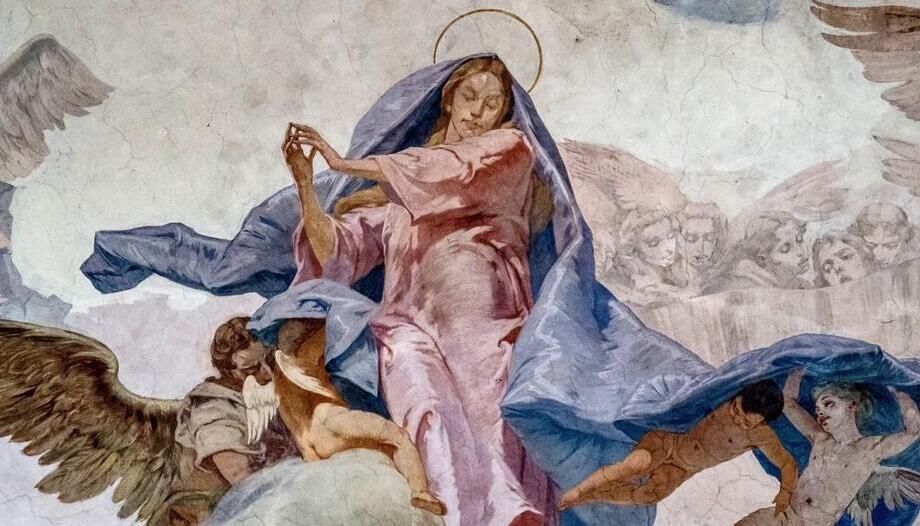Testo originale del articolo in inglese qui
The veneration of the Virgin Mary has existed since the earliest times of Christianity. Even in the Gospels the figure of Mary is of great importance, even if treated with sobriety. Already in the second century the Fathers of the Church, like Giustino and Ireneo, considered her the "new Eve" who collaborated to the redemption of the world, and the apocryphal writings of that time exalted her virgin power and presented her with an almost angelic dignity.
The first Marian celebrations In the third century, the prayer "Sub tuum praesidium" speaks of the power of intercession that Christians attribute to the Virgin Mary. We also know a series of Marian innaments that were sung towards the end of the fourth century, even before the Council of Ephesus proclaimed only in 431 that Mary is the Mother of God ("Theotókos").
The Gerusalemme of the middle of the fifth century knew only one liturgical commemoration of Mary. This commemoration took place in a church located halfway between Gerusalemme and Bethlehem. We know this because the liturgical calendar in the Armenian language has been preserved with the feasts and commemorations that were then celebrated in the Holy City.
This calendar also includes the letters for each celebration. One of its words stated the following: "August 15: Mary Theotokos: in the second half of May from Bethlehem". It was not the feast of the Assumption that we celebrate today, but the feast of the Falling asleep of Mary, which from this century on has preceded the Assumption. That day commemorated the repose of the Mother of God ("Theotókos").
The 'riposo
What was it about? At that time, there was a legend according to which Mary, already unborn, was forced to rest during the journey to Bethlehem. An ancient apocryphal text, the "Protovangelo di Santiago", tells that, halfway between Gerusalemme and Bethlehem, Mary, already close to childbirth, felt stunned and sat down from the chair to rest a little: the moment of the virgin birth was approaching. In memory of this legendary episode, in this same place a pious Christian woman named Hikelia, around the middle of the fifth century, had a church built which, naturally, was called the Church.
del Riposo or "Kathisma" (in ancient Greek "sede" or "place" of the riposo). This church, of which still preserves one of the pianta, has as center the rock on which it is said that Maria sedette to rest. The Armenian calendar refers to it.
Therefore this calendar tells us that in the church of the "Kathisma" there was a Marian memorial of Mary, Mother of God. The letters of that day contained the prophetic note of Isaiah on the Vergine who conceives and delivers Emmanuele ("God with us") and the text in which St. Paul tells the Galatians that "when the thought of the times came, God sent his Son, born of a woman". It was therefore a memoir in which everything was linked to the birth of Jesus and the virgin birth of Mary.
The Feast of the Assumption of the Vergine
But now, how did we come to celebrate on August 15 a feast that does not commemorate the birth of Jesus by a virgin mother, but his Assumption to heaven? A later calendar (which probably dates back to the end of the fifth or sixth century), similar to the Armenian one but preserved in Georgian language, reports a
different practices. In this context, it is still present the Marian re-evocation that is celebrated in the Church of Riposo, no longer on August 15, but anticipated to the 13 of the same month. This calendar indicates instead August 15 as the date of a new Marian re-evocation, which this time was celebrated in the church of Gethsemani, near the garden where Jesus had prayed before his passion.
Some apocryphal writings placed there the place where the body of Mary was deposited after her death, before the Signore asked for it in heaven. According to these writings this church contained the empty tomb of Mary. The letters and the inscriptions of this Georgian calendar show that already at that time there is a
commemoration of the Dormizione e del trasferimento della Vergine in cielo.
A universal festival
God did not allow the body of his Mother to remain in the tomb. Only at the end of the fifth century, Christians celebrated this beautiful grace in the church of Gethsemani. In the following century, the wide diffusion of these apocryphal writings on the Dormition and Glorification of Mary favored the diffusion of this Marian re-evocation of Gethsemani. It was in this way that the memory began to be celebrated also
in other places, to the point that, at the end of the sixteenth century, the emperor Maurizio decreed that it be celebrated as a feast throughout the empire. Rome instituted this feast half a century later, in the seventh century, calling it the Feast of the Assumption of Mary into Heaven. The Marian feast of August 15th would soon become the most solemn and popular of the Marian celebrations in Rome.












